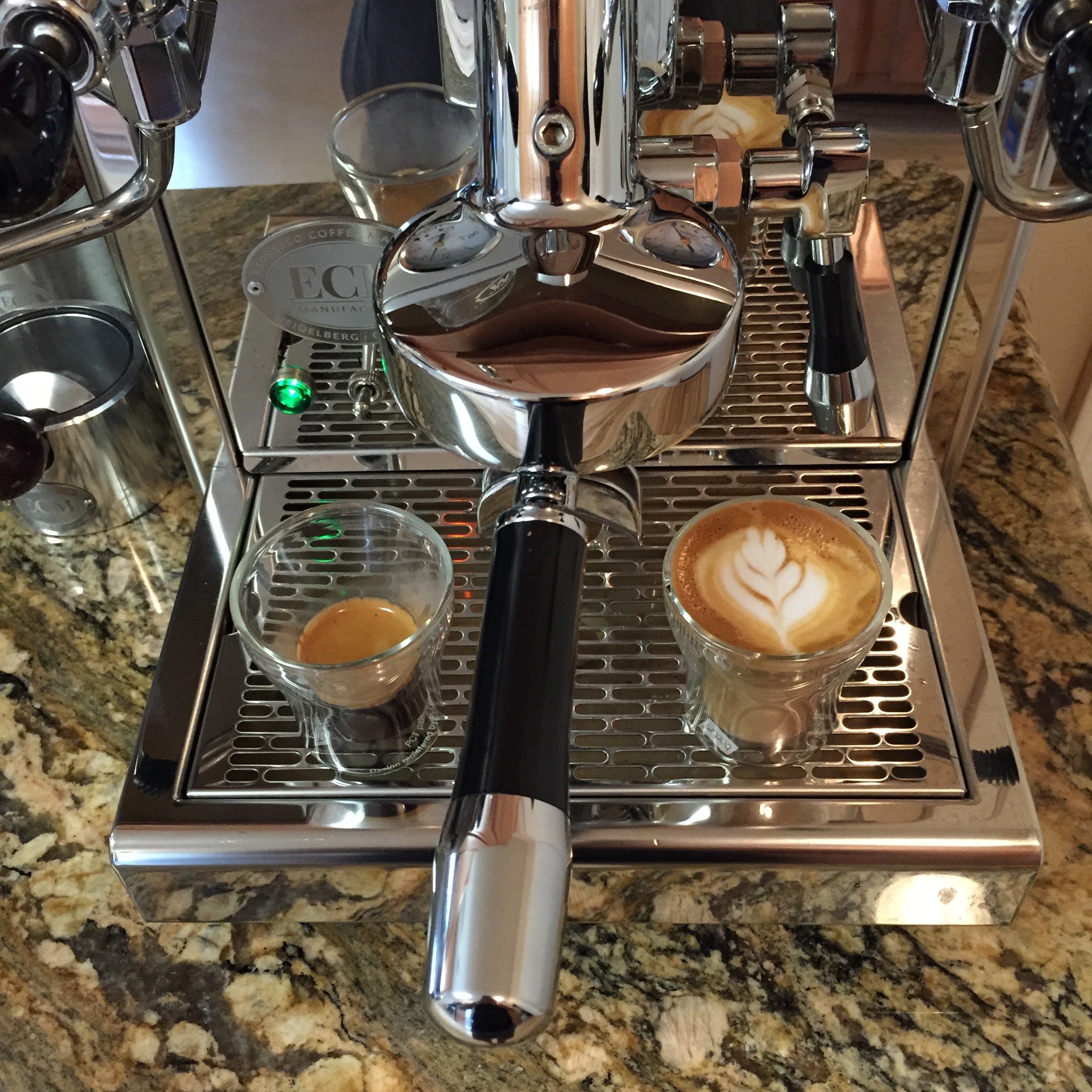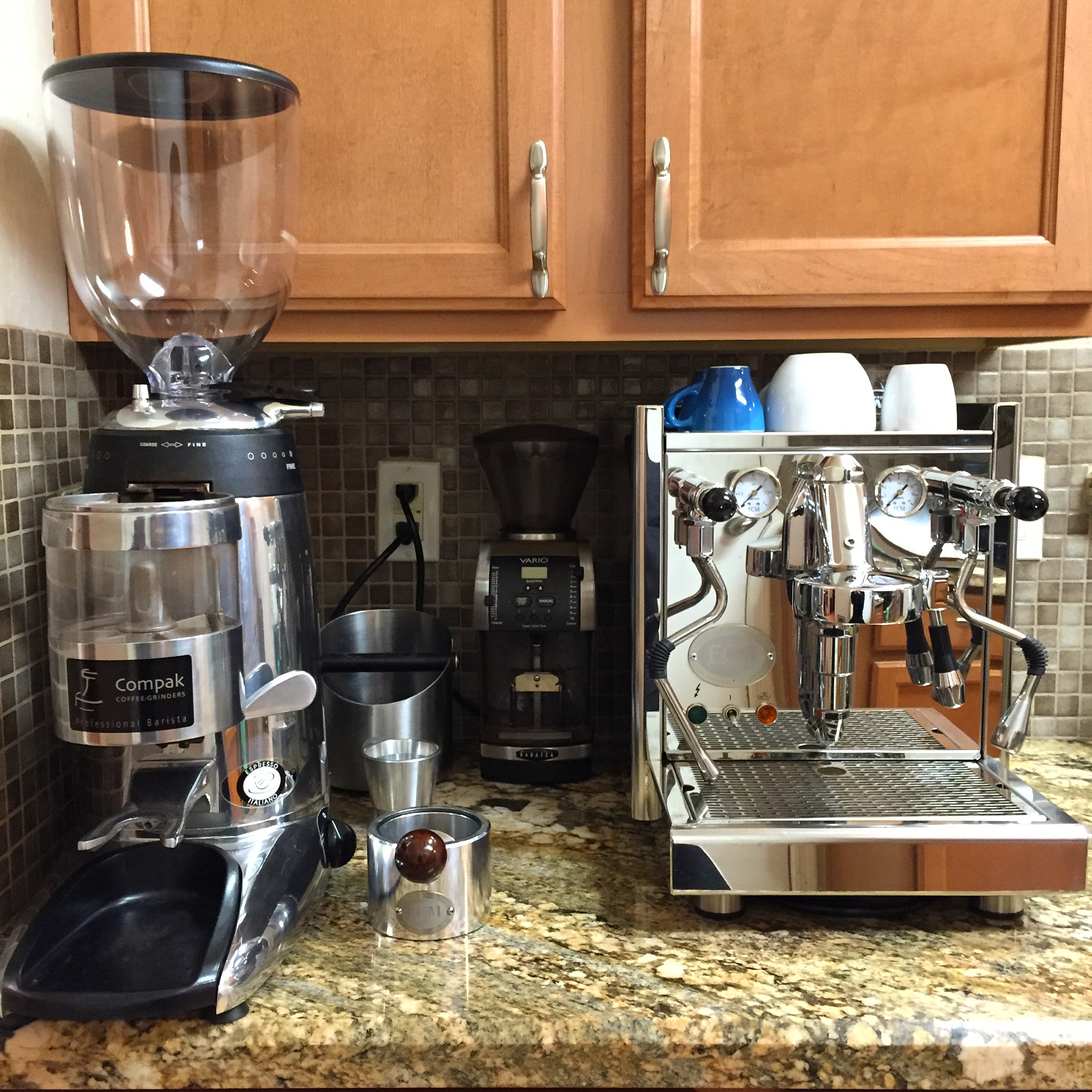There's no shortage of reviews, buyer's guides, and promoted posts across coffee sites, forums, and social media, and when I'm thinking about making a purchase, I love that. What I don't always love is how I need to piece it all together: filter though consumer bias, what's popular, brand promotion, and the noise. So rather than add to the noise, I'm not going to necessarily suggest what to buy, but how to buy it. In this post, I'm going to dive into how I went about plopping down $2-large for my espresso machine: why I chose the machine I did, what considerations came into play, do I have any regrets, long term thoughts, take-aways, and would I do it all over again. Today's Purchasing Process dives into the/my ECM Technika IV Profi Espresso Machine.
Feeling as though I had outgrown my Gaggia Classic, I started to dive into what it is that I wanted to gain over the single-boiler-dual-use machine, what was available at various price points, and what the differences would mean to me in the long run. I knew I wanted to gain consistency, temperature stability, steaming power, output capacity - I wanted a machine that could do more and better. With those attributes in mind, one has to move away from the SBDU and hybrid units and to heat-exchangers (HX's) and dual-boilers (DB's). < This link does a plenty good job of diving into the differences of the mechanics of the different types of machines, so I won't go into length as to what is right or wrong for your or me. Basically, the gamut of HX's and DB's run from $1200 or so to well over $4k while still being consumer, and not necessarily professional oriented. Virtually all of the machines in this price range are capable of meeting my goals of a new machine and pulling great shots when paired with an adequate (or better) grinder and sound technique. And in some cases, many of the machines get to that same end result in the same or very similar ways, just look at all of these "different" E-61 HX's.
The differences largely fall to aesthetics (and even then to the non coffee geek, they will all look like shiny steel boxes), layout and how well thought out the placement of items and machine ease of use, bells and whistles such as lever steam and hot water wands, accessories, and fit and finish on items such as how well the machine is put together - are there any gaps in the panels, rough edges, or areas prone to scratching, rattling, or flex? So navigating machines in this space is somewhat vague and largely personal preference. I would always recommend the following:
Performance - Quality - Price : Pick 2.
This is what it really comes down to: would you rather spend a little more money and get a higher level of fit an finish, OR perhaps save a bit but sacrifice heat stability or steaming power? These are the kinds of questions one needs to ask and answer to help qualify finding the happy medium or the right balance based on your pyramid of priorities. For me, it was Performance and Quality and the top and Price a close second. I know I just said it's a priority pyramid, but when you know two attributes are important, than it just comes down to finding the best priced machine that most closely fulfills and balances those priorities. On the performance side, I was seeking consistency, repeat-ability, and control. Though price is always a very strong determining factor in all of my purchases, I knew that I wanted a quality machine, one that I could use for years and not feel as if I was leaving anything on the table. One that would hold value well, be easily serviceable, rock solid, and refined. I had decided that since this is something that I very much enjoy doing, I wanted to spend the money needed to buy what I wanted rather than settle, buy nice instead of buy twice.
At that time (Summer 2014) it meant I could buy a more entry level DB or a top-tier HX. I chose the latter; an E-61 heat-exchanger with just about everything you could want or need out of a prosumer HX machine. There are some great options now that were not on the market when I made my decision, and I will cover my list of recommended options at various price points in the next post. I went with an HX over a DB, partially because the manual, on-the-fly temperature control of an HX appealed to me, much in the way the frequently used analogy of a manual transmission versus an automatic does. I liked the ability to pull hotter or cooler shots at will and readily switch between coffees and manipulate the end result. I also knew I wanted a rotary pump, because I wanted the ability to plumb the machine with a direct water connection, rather than having to routinely fill (and clean) the water tank. Machines with rotary pumps generally cost more, so this also pointed in the direction of an HX. And lastly, I was (thankfully) starting to realize that I greatly valued the well engineered and well made. That fit and finish were important to me, and it would provide more enjoyment to use and look at everyday to have everything just so functionally and aesthetically. This meant, I needed to spend more on fit and finish, which really narrowed down to two clear options, the ECM Technika IV Profi and the Bezzera Mitica. Not so coincidentally, the machines are actually manufactured in the same facility and have many of the same parts. The only real differences between the two are the gauge placement (high vs low), and boiler material (stainless steel vs copper). Ultimately, I found the aesthetics to be slightly favorable on the ECM and the stainless boiler also had appeal. The inlays on the portafilter and pump activation lever are also slightly more refined on the Technika. There are definitely a few other machines out there that fall into this category and were contenders, but ultimately these two had the most visual appeal to me.
To go about buying any espresso machine, make sure to call the retailer. The price you see online is often times not their best price, especially with the more expensive machines. Buying a grinder too? Even better, you have more bargaining power for a package deal. Don't limit yourself to just price either, often times accessories can sweeten the deal even more. And lastly, buy the seller. Even if the machine is under warranty, consider the seller's ability to access parts, and how responsive and reputable they are. Because the last thing you want to have to do is pack the behemoth up and ship it back across the country. A responsive retailer might be able to send you a part or help troubleshoot the issue over the phone to get you back up and running. Luckily, I have not had any issues with my machine, but I'm careful to only provide links to retailers I would be comfortable purchasing from myself. so now, nearly two years after owning the machine, how do I feel about it?
Ownership Report
The Technika is everything I was seeking. It is extremely well built, with a very high level of fit and finish. It's a joy to use, pulls great shots, and steams very well too. With so many detailed reviews I won't go on about the machine in specific, if you do care to read more, this review from Mr. Home-Barista himself is very informative.
Do I have any take-aways? Yes, the gauge placement that I was for whatever reason stuck on is a non-issue. And actually, if you're one to monitor your shots by flow, especially when looking up at the extraction with a naked portafilter, the lower gauge placement of the Mitica is actually easier to reference. I also don't know if the boiler material will ever really factor in. You should always use water of the proper hardness, acidity, and with the correct amount of dissolved solids. To read more on the water science, I'd recommend starting with Jim Schulman's Insanely Long Water FAQ. Build quality, to me, is absolutely important. The machine doesn't have any flex in the frame of the metal panels when locking the portafilter in or out, and feels solid. There aren't any unfinished edges or areas that I wish they would have done differently really - well except the screw to adjust the pump pressure is under the machine, so it's not the easiest to get to, but it's not like it needs changing often, if at all.
Although, I do not have any regrets of my machine, and find the temperature management (flushing routine) of an HX machine to be very manageable, consistent, and repeatable, my rationale for choosing an HX over a DB isn't as relevant as I initially thought. The HX had a lot of appeal with the ability to change temperature on the fly. So if I was dialing in a coffee I could try one shot hot and one shot cooler, or if I switched coffees. In reality, even if I'm dialing in a coffee, I'm not chugging them back to back, so the 15-30 minutes needed for a DB machine to re-stabilize at a newly selected temperature is not necessarily a limiting factor. There are less moving parts with and HX having half as many boilers as a DB, but as I stated before, good retail support makes this a less significant issue in many cases. There are also more dual boiler machines on the market today, as it seems to be what the market prefers, with HX's being slightly out of favor as of recent. I think this is because seeing a temperature readout on a PID display, even if not accurate, adds some piece of mind or comfort to the end user since they can see what the machine is reading, rather than look, listen, and learn the machine. I would give strong consideration to more dual boilers if I were to do it again. (Though that isn't to say I wouldn't choose the same machine, it's a great fit for me). I'll cover the options I do prefer and why at various price points in a future post. And if you're in the process of trying to select an espresso machine, but not sure which is right for you, feel free to contact me. I'm happy to kick some thoughts and various perspectives back and forth to see what would be a good fit.







